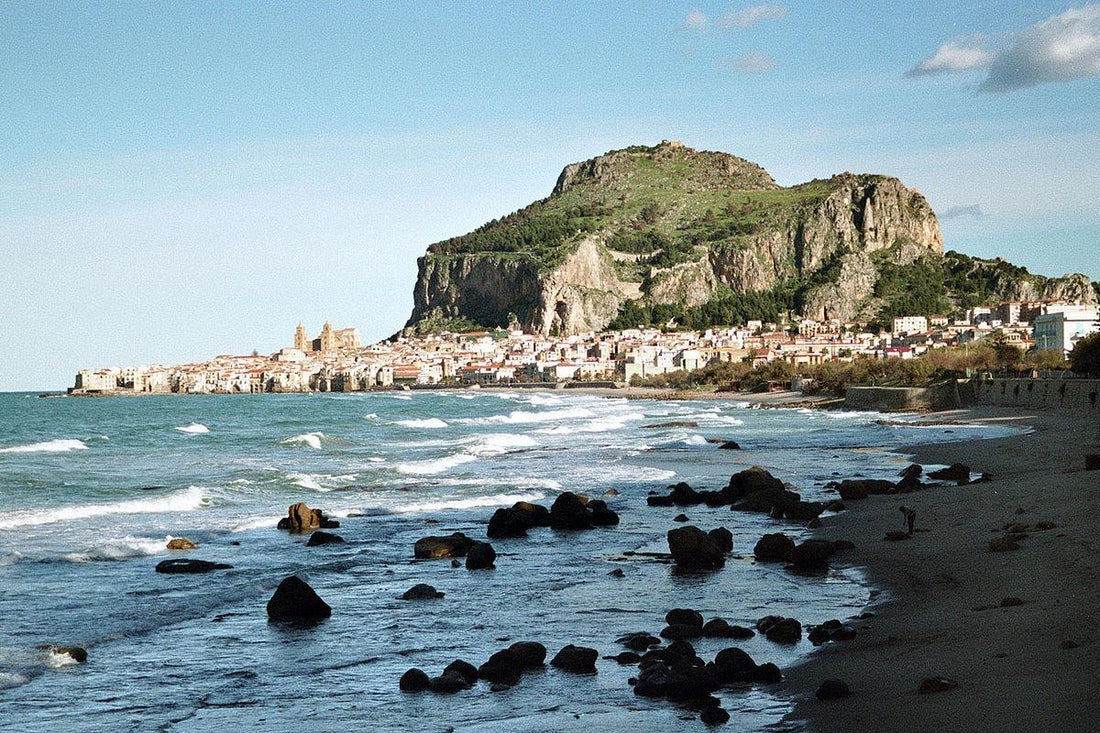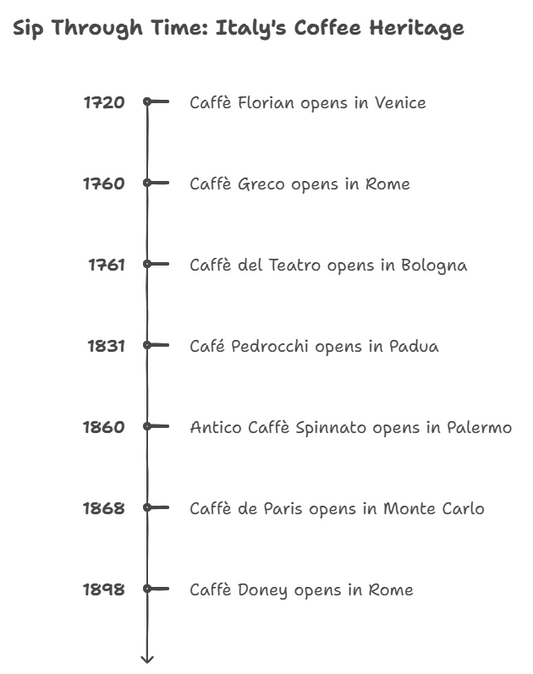Cefalù, is a town in northern Sicily, Italy. It lies at the foot of a 1,233-foot (376-metre) promontory along the Tyrrhenian Sea, east of Palermo city.

Image of beautiful Cefalù from https://en.m.wikipedia.org/wiki/Cefalù
Map of Sicily, Italy

Image of map of Sicily: https://www.britannica.com/place/Sicily
Map of Cefalu, Sicily

https://www.pinterest.com/pin/262053272056153181/
The city originated as the ancient Cephalaedium, which was probably founded as an outpost of the Greek city of Himera and first appeared in history about 395 BC as an ally of the Carthaginian leader Himilco.

Image of Himilco from https://www.pinterest.com/pin/560698222338117834/
Valued for its strategic position on the height of the promontory, the ancient town was in turn conquered by the Syracusan tyrants Dionysius I and Agathocles and by the Carthaginians, from whom the Romans seized it in 254 BC.

Sculpture of Dionysius I: https://www.britannica.com/biography/Dionysius-I

Image of tyrant Agathocles : https://www.ancient-origins.net/history-famous-people/agathocles-0012423
In the First Punic War, which began in 264BC, the tyrants were reduced by the Roman fleet under Atilius Calatinus and Scipio Nasica, 254 BC, but by treachery and not by force of arms.
Map of areas affected by First Punic War:https://en.wikipedia.org/wiki/First_Punic_War#/media/File:First_Punic_War_264_BC_v2.png
Aulus Atilius Calatinus

Drawing of Aulus Atiliuss Calatinus: https://enacademic.com/dic.nsf/enwiki/47756
Aulus Atilius Calatinus was a politician and general in Ancient Rome. He was the first Roman dictator to lead an army outside Italy.
A consul (which means an officer appointed by a state to live in a foreign city and protect the state’s citizens and interest there) in 258BC and again in 254BC, a praetor (Roman magistrates ranking below consul) and triumphant (one to whom an ovation is given) in 257BC and finally a censor in 247BC, he was believed to have died in 216BC.
Scipio Nasica

An Illustration of Scipio Nasica: https://www.lookandlearn.com/history-images/M818431/Scipio-Nasica
Publius Cornelius Scipio Nasica Corculum (c. 206 BC – c. 141 BC) was a politician of the Roman Republic. Born into the illustrious family of the Cornelii Scipiones, he was one of the most important Roman statesmen of the second century BC and is a
- consul two times in 162 and 155 BC,
- censor (meaning a magistrate who held censuses and supervised public morals) in 159 BC,
- Pontifex Maximus (chief priest) in 150 BC, and
- finally Princeps Senatus (leader of the Senate) in 147 BC.
Marcus Tullius Cicero

Sculpture of Marcus Tullius Cicero: https://en.wikipedia.org/wiki/Cicero
Marcus Tullius Cicero (3 January 106 BC – 7 December 43 BC), most commonly known as simply Cicero, was a Roman statesman, lawyer and Academic Skeptic philosopher who played an important role in the politics of the late Republic and vainly tried to uphold republican principles during the crises that led to the establishment of the Roman Empire.
With his extensive writings of treatises on rhetoric, philosophy, and politics, he is considered one of Rome's greatest orators and prose stylists He came from a wealthy municipal family of the Roman equestrian order and served as consul in the year 63 BC.
Cicero speaks of Cefalu as apparently a flourishing town, enjoying full municipal privileges; it was, in his time, one of the civitates decumanae (a kind of payment made to the Roman magistrate) which paid the tithes (meaning one-tenth) of their corn in kind to the Roman state. This has caused much distress to the farmers at that time.
Gaius Verres

Potrait of Gaius Verres – https://famous-trials.com/gaius-verres/59-firstbook
One of the Roman magistrate, Gaius Verres (c. 120–43 BC) was a Roman magistrate, notorious for his misgovernment of Sicily. His extortion of local farmers and plundering of temples led to his prosecution by Cicero, whose accusations were so devastating that his defense advocate could only recommend that Verres should leave the country.
After the fall of the Western Roman Empire, the town remained part of the Eastern Roman (Byzantine) Empire and the settlement was eventually moved from the plain to the current spur for defense, like many cities during the Byzantine era, as the Mediterranean was no longer solely controlled by the empire and was subject to Arab incursions.Nevertheless, the old town was never entirely abandoned. In AD 858, after a long siege, it was conquered by the Arabs. For the following two centuries it was part of the Emirate of Sicily.
Norman King Roger II
In 1063, the Normans captured the city. This new town was founded at the foot of the promontory nub by the Norman king Roger II in AD 1131, the year in which Cefalù’s famous cathedral begun.

Image of King Roger II (Source: https://en.m.wikipedia.org/wiki/Roger_II_of_Sicily)
Roger II (22 December 1095 – 26 February 1154) was King of Sicily and Africa, son of Roger I of Sicily and successor to his brother Simon. He began his rule as Count of Sicily in 1105, became Duke of Apulia and Calabria in 1127, then King of Sicily in 1130 and King of Africa in 1148.
By the time of his death at the age of 58, Roger had succeeded in uniting all the Norman conquests in Italy into one kingdom with a strong centralized government.
Norman Cathedral

Image of Norman Cathedral: https://www.britannica.com/place/Cefalu
This cathedral was built by the Normans, native to Scandinavia, who occupied the island between the 11th and 13th centuries. The exterior of the cathedral is well preserved, with massive four-story towers on each side of the facade.
They combined Islamic traditions and influences from the Eastern Roman Empire (known as Byzantine) to give origin to a unique style of art and architecture. The construction of the cathedral started in 1131, but it wasn't completed until 1240.

Image of interior of Norman cathedral: https://study.com/academy/lesson/cefalu-cathedral-interior-mosaics.html
The altar area has a vaulted roof, reinforced by crossed ribs. It was built using white stone, and it is outstanding for its decoration.
Many sculptures were built into the walls and ceiling of this part of the cathedral, especially carvings. They give this section a very embellished and ornate look, which contrasts with the rather sober style of the other areas.
The cathedral’s interior was considerably restored in the 16th and 17th centuries. The Byzantine-style mosaics in the apse and the first spaces between the arches of the choir (1148) are among the most beautiful in Sicily.
La Rocca

Image of La Rocca: Image of La Rocca: https://trip101.com/article/top-things-you-should-do-in-italian-cefalu

La Rocca from the top: https://www.picfair.com/pics/08110577-view-from-rocca-di-cefalu
Built by the then King of Sicily, Roger II in 1131 as an act of gratitude for surviving a bad storm and landing on the town's beach.
La Rocca is the site where the town was originally established. Today. There are ruins from many different periods, including the pre-Hellenic temple of Diana and a castle built in 12C and 13C.


Remains of the Temple of Diana - https://commons.wikimedia.org/wiki/File:Tempel_van_Diana-Cefalu.jpg
& http://www.visitsitaly.com/sicily/cefalu/cefalu-pix.htm
Gem of the Sicilian coast
Cefalù is a beautiful and exciting city with a long history. For its beauty, it deserves your attention, whether you appreciate sunny beaches or exploring historical monuments.
With a location just below a cliff and along the beautiful Sicilian coastline, Cefalù is the perfect combination of nature and humanity, representing ancient life in the Middle Ages.
Sources
- https://en.m.wikipedia.org/wiki/Cefalù
- https://en.m.wikipedia.org/wiki/Roger_II_of_Sicily
- https://study.com/academy/lesson/cefalu-cathedral-interior-mosaics.html
- https://trip101.com/article/top-things-you-should-do-in-italian-cefalu
- https://rome.fandom.com/wiki/Aulus_Atilius_Calatinus
- https://en.wikipedia.org/wiki/Publius_Cornelius_Scipio_Nasica_Corculum
- https://en.wikipedia.org/wiki/Cicero
- https://en.wikipedia.org/wiki/Verres




